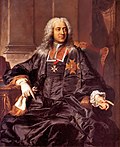| Order of Saint Louis Ordre de Saint-Louis | |
|---|---|
 Cross of the Order of Saint Louis | |
| Awarded by the King of France | |
| Type | Dynastic order |
| Established | 5 April 1693 |
| Royal house | House of France |
| Religious affiliation | Roman Catholicism |
| Ribbon | Bright red |
| Motto | Bellicæ virtutis præmium (Latin for 'the reward of warring valor') |
| Eligibility | Military officers of Catholic faith with over 10 years of service, including non-nobles |
| Awarded for | Exceptional merit |
| Status |
|
| Founder | Louis XIV |
| Precedence | |
| Next (higher) | Order of Saint Michael |
| Equivalent | Order of Military Merit awarded to non-Catholics |
| Ribbon of the order | |
The Royal and Military Order of Saint Louis (French : ordre royal et militaire de Saint-Louis) is a dynastic order of chivalry founded 5 April 1693 [1] [2] by King Louis XIV, named after Saint Louis (King Louis IX of France). It was intended as a reward for exceptional officers, notable as the first decoration that could be granted to non-nobles. By the authorities of the French Republic, it is considered a predecessor of the Legion of Honour, with which it shares the red ribbon (though the Legion of Honour is awarded to military personnel and civilians alike).
Contents
Although officially abolished by the government authorities of the July Revolution in 1830 following the French Revolution, its activities carried on as a dynastic order of the formerly sovereign royal family. As such, it is still recognised by the International Commission on Orders of Chivalry. [3]









